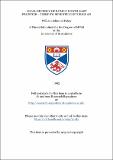Local defence of Rome's north-east frontier - third to seventh centuries AD
Abstract
The purpose of this thesis is to examine the function of local communities in the defence of the late Roman Empire along the North-East frontier. The North-East is defined as those lands between 37 and 49 degrees longitude east and 42 and 36 degrees latitude north, encompassing territories in northern Syria, northern Mesopotamia, Armenia, and Georgia. Efforts at controlling this region had to take into account a variety of communities and environmental conditions. The diversity of the terrain impeded easy unification of the region. Throughout Antiquity attempts were made to overcome these barriers through projects which largely revolved around specific urban centres. Such centres provided points through which imperial powers controlled the periphery via local agents. In order to establish the difficulties faced by both local communities and the late Roman government, the successes and failures of previous imperial powers at controlling the region shall be surveyed. During the fourth century a defensive strategy in which the Roman army avoided pitched battles and increasingly relied on specialists, the limitanei, and the subject population to keep invaders at bay, was developed in the North-East. The imperial government carefully used traditional power structures and local customs to secure the loyalty of both provincial leaders and subjects. This can be observed in detailed studies of several important frontier settlements. Armenian sources have been used in conjunction with Classical literature to create an enriched picture of the North-East. The Christian hierarchy was central to the late Roman government's control of the frontier communities. While they rarely held legitimate military authority, the clergy played a tremendous part in bolstering the morale of commanders, troops, and citizens. They were called upon to arbitrate judicial cases within the empire, and following this development, they acted as intermediaries between imperial courts, opposing armies, and mutinous troops. The Church's missionary efforts and communication with Christian communities on all sides of the frontier made clerics useful agents for negotiation and a valuable source of information. As a consequence, Christianity influenced the development of diplomacy in the region and was in turn influenced by political and military matters. It is debatable whether the late Roman state had developed any sort of "grand strategy" in the North-East. Yet the willingness to support local initiative over the course of three hundred years suggests that the imperial government consciously followed a consistent policy, not unlike that employed during early periods with regards to client kings.
Type
Thesis, MPhil Master of Philosophy
Collections
Items in the St Andrews Research Repository are protected by copyright, with all rights reserved, unless otherwise indicated.

